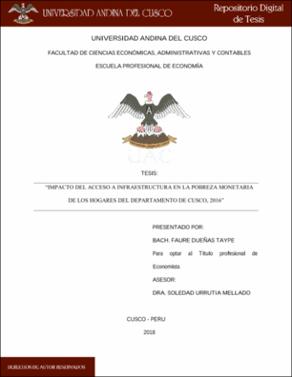| dc.contributor.advisor | Urrutia Mellado, Benedicta Soledad | |
| dc.contributor.author | Dueñas Taype, Faure | |
| dc.date.accessioned | 2018-11-05T14:37:12Z | |
| dc.date.available | 2018-11-05T14:37:12Z | |
| dc.date.issued | 2018-08-27 | |
| dc.identifier.uri | https://hdl.handle.net/20.500.12557/1976 | |
| dc.description.abstract | En el presente documento se analiza el impacto que tiene el acceso a infraestructura en la reducción de la pobreza monetaria de los hogares del departamento de Cusco, partiendo de un enfoque de activos. Aunque el crecimiento económico y la acción de programas sociales han contribuido de forma importante a la reducción de la pobreza en el Perú y Cusco, el porcentaje de hogares que vive por debajo de la línea de pobreza es aún muy alto y preocupante. Por medio de estimación de modelos logit de variable dependiente binomial se consigue medir el impacto que tiene el acceso a infraestructura en la pobreza monetaria de los hogares. Para la estimación del modelo se usó información a nivel de hogares a partir de la Encuesta Nacional de Hogares (ENAHO) del INEI para el año 2016. Además, se consideran resultados diferenciados según el área de residencia del hogar (urbana o rural). Para medir el impacto de la infraestructura sobre la pobreza de los hogares se toma en cuenta el acceso a cuatro tipos de infraestructura básica: agua potable, desagüe, electricidad y telefonía. Los resultados obtenidos indican que el acceso tanto a telefonía como a desagüe tienen un impacto significativo en la reducción de la pobreza monetaria de los hogares, teniendo estas infraestructuras mayor impacto en el área rural. Esto significa que los hogares que tienen acceso a telefonía tienen menos probabilidad de ser pobres que los hogares que no cuentan con este servicio. De igual forma los hogares que tienen acceso a desagüe tienen menos probabilidad de ser pobres que los hogares que no cuentan con esta infraestructura. Asimismo, la probabilidad de ser pobre disminuye en gran medida cuando los hogares pasan de no contar con ninguna infraestructura a tener acceso conjunto a las cuatro infraestructuras consideradas. | es_PE |
| dc.description.abstract | The present document analyzes the impact that access to infrastructure has on reducing the monetary poverty of households in the department of Cusco, based on an asset approach. Although economic growth and the action of social programs have contributed significantly to the reduction of poverty in Peru and Cusco, the percentage of households living below the poverty line is still very high and worrisome. By means of estimation of logit models of binomial dependent variable, it is possible to measure the impact that access to infrastructure has on the monetary poverty of households. For model estimation, information at household level from ENAHO (Encuesta Nacional de Hogares) provided by INEI was used, for the year 2016. In addition, different results are considered according to the area of residence of the household (urban or rural). Access to four types of basic infrastructure: drinking water, drainage, electricity and telephony is taken into account to measure the impact of infrastructure on household poverty. The results obtained indicate that access to both telephony and drainage have a significant impact on the reduction of household monetary poverty, having these infrastructures a
greater impact in rural areas. This means that households that have access to telephony are less likely to be poor than households that do not have this service. Similarly, households that have access to drainage are less likely to be poor than households that do not have this infrastructure. Likewise, the probability of being poor decreases to a great extent when households go from not having any infrastructure to having joint access to the four infrastructures considered. | en_US |
| dc.description.uri | Tesis | es_PE |
| dc.format | application/pdf | es_PE |
| dc.language.iso | spa | es_PE |
| dc.publisher | Universidad Andina del Cusco | es_PE |
| dc.rights | info:eu-repo/semantics/openAccess | es_PE |
| dc.rights.uri | https://creativecommons.org/licenses/by-nc-nd/2.5/pe/ | es_PE |
| dc.source | Universidad Andina del Cusco | es_PE |
| dc.source | Repositorio Institucional - UAC | es_PE |
| dc.subject | Pobreza | es_PE |
| dc.subject | Impacto | es_PE |
| dc.subject | Infraestructura | es_PE |
| dc.subject | Servicios básicos | es_PE |
| dc.subject | Hogares | es_PE |
| dc.title | Impacto del acceso a infraestructura en la pobreza monetaria de los hogares del departamento de Cusco, 2016. | es_PE |
| dc.type | info:eu-repo/semantics/bachelorThesis | es_PE |
| thesis.degree.name | Economista | es_PE |
| thesis.degree.grantor | Universidad Andina del Cusco. Facultad de Ciencias Económicas, Administrativas y Contables | es_PE |
| thesis.degree.level | Titulo Profesional | es_PE |
| thesis.degree.discipline | Economía | es_PE |


